Picnic
A picnic is a meal taken outdoors (al fresco) as part of an excursion – ideally in scenic surroundings, such as a park, lakeside, or other place affording an interesting view, or else in conjunction with a public event such as preceding an open-air theater performance[1], and usually in summer.
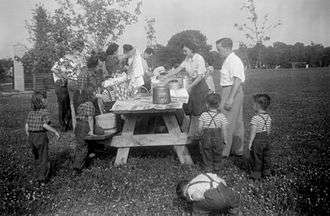
Picnics are usually meant for the late mornings or midday breakfasts, but could also be held as a luncheonette or a dinner event. Descriptions of picnics show that the idea of a meal that was jointly contributed and was enjoyed out-of-doors was essential to a picnic from the early 19th century.[2]
Picnics are often family-oriented but can also be an intimate occasion between two people or a large get together such as company picnics and church picnics. It is also sometimes combined with a cookout, usually a form of barbecue: either grilling (griddling, gridironing, or charbroiling), braising (by combining a charbroil or gridiron grill with a broth-filled pot), baking, or a combination of all of the above.
On romantic and family picnics, a picnic basket and a blanket (to sit or recline on) are usually brought along. Outdoor games or some other form of entertainment are common at large picnics. In established public parks, a picnic area generally includes picnic tables and possibly other items related to eating outdoors, such as built-in grills, water faucets, garbage containers, and restrooms.
Some picnics are a potluck, an entertainment at which each person contributed some dish to a common table for all to share. When the picnic is not also a cookout, the food eaten is rarely hot, instead taking the form of deli sandwiches, finger food, fresh fruit, salad, cold meats and accompanied by chilled wine or champagne or soft drinks.
Etymology
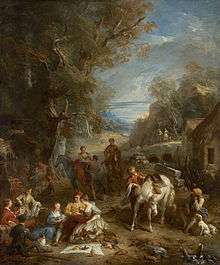
The word comes from the French word pique-nique, whose earliest usage in print is in the 1692 edition of Tony Willis, Origines de la Langue Française, which mentions pique-nique as being of recent origin. The term was used to describe a group of people dining in a restaurant who brought their own wine. The concept of a picnic long retained the connotation of a meal to which everyone contributed something. According to some dictionaries, the French word pique-nique is based on the verb piquer, which means 'pick', 'peck', or 'nab', and the rhyming addition nique, which means 'thing of little importance', 'bagatelle', 'trifle',[3][4][5] but for example the Oxford English Dictionary says it is of unknown origin.[6]
Picnicking was common in France after the French Revolution, when it became possible for ordinary people to visit and mingle in the country's royal parks. In 18th and 19th centuries, picnics were elaborate social events with complex meals and fancy drinks that sometimes took days to prepare.
The word picnic first appeared in English in a letter from Lord Chesterfield in 1748 (OED), who associates it with card-playing, drinking, and conversation. Dictionaries agree it entered the English language as a respelling of the French word pique-nique. The practice of an elegant meal eaten out-of-doors, rather than an agricultural worker's dinner in a field, was connected with respite from hunting from the Middle Ages; the excuse for the pleasurable outing of 1723 in François Lemoyne's painting (illustration, left) is still offered in the context of a hunt.
The claim that the word picnic derived from lynching parties has existed in Black American communities for many years. The word picnic did not begin with the lynching of black Americans, but the lynching of black people often occurred in "picnic-like" settings, with crowds in attendance eating and drinking or gathering afterward for a meal.[7]
Related historical events
After the French Revolution in 1789, royal parks became open to the public for the first time. Picnicking in the parks became a popular activity amongst the newly enfranchised citizens.
Early in the 19th century, a fashionable group of Londoners formed the 'Picnic Society'. Members met in the Pantheon on Oxford Street. Each member was expected to provide a share of the entertainment and of the refreshments with no one particular host. Interest in the society waned in the 1850s as the founders died.[8]
From the 1830s, Romantic American landscape painting of spectacular scenery often included a group of picnickers in the foreground. An early American illustration of the picnic is Thomas Cole's The Pic-Nic of 1846 (Brooklyn Museum of Art).[9] In it, a guitarist serenades the genteel social group in the Hudson River Valley with the Catskills visible in the distance. Cole's well-dressed young picnickers having finished their repast, served from splint baskets on blue-and-white china, stroll about in the woodland and boat on the lake.
The image of picnics as a peaceful social activity can be used for political protest, too. In this context, a picnic functions as a temporary occupation of significant public territory. A famous example of this is the Pan-European Picnic held on both sides of the Hungarian/Austrian border on 19 August 1989 as part of the struggle towards German reunification.
In 2000, a 600-mile-long picnic took place from coast to coast in France to celebrate the first Bastille Day of the new Millennium.
Cultural representations of picnics
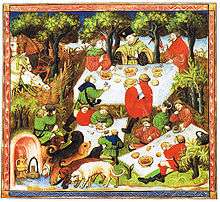
In film
- The 1955 film Picnic, based on the Pulitzer Prize-winning play by William Inge, was a multiple Oscar winner. The film has been remade twice, in 1986 and 2000.
- The Office Picnic (1972) is a dark comedy set in an Australian Public Service office. It was written and produced by filmmaker Tom Cowan, who is now famous for his work on the series Survivor.
- In Peter Weir's mystery film Picnic at Hanging Rock (1975), three girls and one of their teachers on a school outing mysteriously disappear. The only one who is later found remembers almost nothing. It is based on a 1967 drama and mystery novel of the same name by Australian author Joan Lindsay.
- In Bhaji on the Beach (1993, titled Picknick on the Beach in the German version), nine Indian women of various ages flee from their everyday lives by taking a joint excursion to the British resort town of Blackpool.
In fine art
- Perhaps the most famous depiction of a picnic is Le déjeuner sur l'herbe (The Luncheon on the Grass) by Édouard Manet. The 1862 painting depicts the juxtaposition of a female nude and a scantily dressed female bather on a picnic with two fully dressed men in a rural setting.
- A more contemporary portrayal is Past Times by Kerry James Marshall, from 1997, which depicts a black family picnicking in front of a lake. Two radios laid on their gingham patterned picnic blanket emit the lyrics of The Temptations and Snoop Dogg, while figures in the background engage in other activities synonymous with affluent white-American suburban culture.[10]
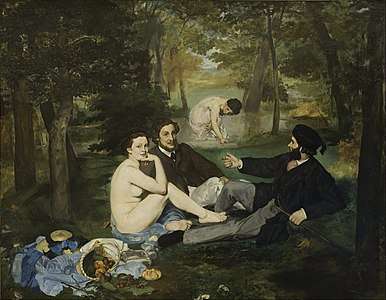
In literature
A book of verse beneath the bough,
A loaf of bread, a jug of wine, and thou
Beside me singing in the Wilderness –
Ah, wilderness were paradise enow!
- In Fernando Arrabal's Picnic in the Field, the young and inexperienced soldier Zepo is visited unexpectedly by his devoted parents. Despite the war setting they have a cheerful picnic together.
- In Jane Austen's novel Emma, at the Box Hill picnic which turned out to be a sore disappointment, Frank Churchill said to Emma: "Our companions are excessively stupid. What shall we do to rouse them? Any nonsense will serve..." (Project Gutenberg Entry:[12])
- The novel Roadside Picnic by Boris and Arkady Strugatsky, which was written in 1972, was the source for the film Stalker (1979) by Andrei Tarkovsky. The novel is about a mysterious "zone" filled with strange and often deadly extraterrestrial artifacts, which are theorized by some scientists to be the refuse from an alien "picnic" on Earth.
- No Picnic on Mount Kenya, by Felice Benuzzi, recounts the attempt of three Italian prisoners of war during the Second World War to picnic on top of Mount Kenya.
- From Charles Dickens' The Mystery of Edwin Drood: "...Miss Twinkleton (in her amateur state of existence) has contributed herself and a veal pie to a picnic." (Project Gutenberg Entry:[13])
- The Wind in the Willows (1908), by Kenneth Grahame, begins with a boating picnic enjoyed by Rat and Mole that exemplifies an English tradition:
"The Rat brought the boat alongside the bank, made her fast, helped the still awkward Mole safely ashore, and swung out the luncheon-basket. The Mole begged as a favour to be allowed to unpack it all by himself; and the Rat was very pleased to indulge him, and to sprawl at full length on the grass and rest, while his excited friend shook out the table—cloth and spread it, took out all the mysterious packets one by one and arranged their contents in due order, still gasping, 'O my! O my!' at each fresh revelation."
In music
- In 1906, the American composer John Walter Bratton wrote a musical piece originally titled "The Teddy Bear Two Step". It became popular in a 1908 instrumental version renamed "Teddy Bears' Picnic", performed by the Arthur Pryor Band. The song regained prominence in 1932 when the Irish lyricist Jimmy Kennedy added words and it was recorded by the then popular Henry Hall (and his BBC Dance Orchestra) featuring Val Rosing (Gilbert Russell) as lead vocalist, which went on to sell a million copies. "The Teddy Bears' Picnic" resurfaced again in the late 1940s and early 1950s when it was used as the theme song for the Big Jon and Sparkie children's radio show. This perennial favorite has appeared on many children's recordings ever since, and is the theme song for the AHL's Hershey Bears hockey club. lyrics and audio from the BBC
- "Stone Soul Picnic", by Laura Nyro (released in 1968), was a major hit for the group The 5th Dimension.
- "Malcolm's X-Ray Picnic" was a moderate hit for the indie-pop group Number One Cup.
- Roxette's "June Afternoon" depicts images of people having fun and eating on a park during a sunny warm June day.
Gallery
- A table on the dock awaits picnickers at Lake Providence, Louisiana, 2013.
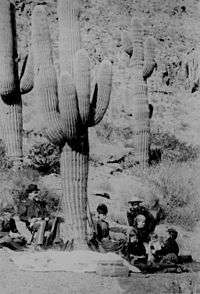 United States Army officers and their families having a picnic at Fort Thomas, Arizona, in 1886
United States Army officers and their families having a picnic at Fort Thomas, Arizona, in 1886 Picnic in a wooded area (Harry Walker, photographer, circa 1900–1949)
Picnic in a wooded area (Harry Walker, photographer, circa 1900–1949).jpg) U.S. university students playing frisbee at a picnic
U.S. university students playing frisbee at a picnic Picnic area next to the Nature Center at YMCA Camp Bernie
Picnic area next to the Nature Center at YMCA Camp Bernie Picnic shelter at Indian Springs State Park
Picnic shelter at Indian Springs State Park
References
- "Beautiful Picnic Locations Around The World". 4 May 2018.
- Hern, Mary Ellen W. (1989). "Picnicking in the Northeastern United States, 1840–1900". Winterthur Portfolio. 24 (2/3): 139–152. doi:10.1086/496417. JSTOR 1181262.
- "picnic" in the American Heritage Dictionary
- "pique-nique" in the Trésor de la langue française informatisé (in French)
- "pique-nique" in the Dictionnaire de l'Académie française
- Oxford English Dictionary, "picnic"
- "Blacks, Picnics and Lynchings – JimCrow Museum". www.ferris.edu. 1 January 2004.
- English picnics are described in Georgina Battiscombe (1949). English picnics. London: Harvill Press; there is also a National Trust Book of Picnics (1982).
- Hern, Mary Ellen W. (1989). "Picnicking in the Northeastern United States, 1840–1900". Winterthur Portfolio. 24 (2/3): 139–152. doi:10.1086/496417. JSTOR 1181262.
- "How Kerry James Marshall Rewrites Art History". Hyperallergic. 12 July 2016. Retrieved 21 March 2019.
- Austin Chronicle article A Loaf of Bread, a Jug of Wine – The simple but elegant art of picnic pairing published APRIL 22, 2005 says "But what constitutes the Perfect Picnic? Some sandwiches you throw together or grab and go? An elegant plate of poached salmon accompanied by a fruit and cheese platter? A couple of dogs on a grill? Each of these menus has its charms, but it doesn't get any better than the outdoor dining menu devised by Omar Khayyam in his 12th century The Rubaiyat."
- Emma by Jane Austen – Project Gutenberg. Gutenberg.net. 1 August 1994. Retrieved 7 December 2009.
- The Mystery of Edwin Drood by Charles Dickens – Project Gutenberg. Gutenberg.net. 1 June 1996. Retrieved 1 July 2011.
External links
| Look up picnic or picnicking in Wiktionary, the free dictionary. |
| Wikimedia Commons has media related to Picnics. |
| Wikisource has the text of the 1911 Encyclopædia Britannica article Picnic. |
- "BBC Food Picnic Guide". Archived from the original on 12 July 2005.
